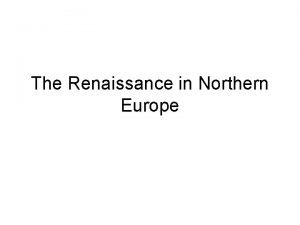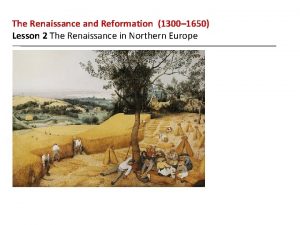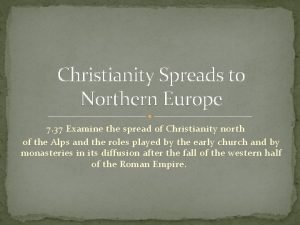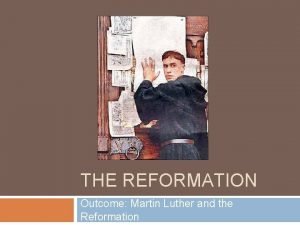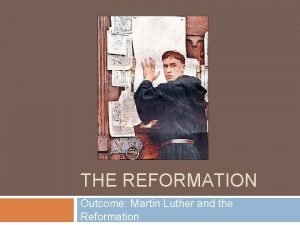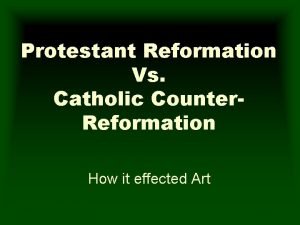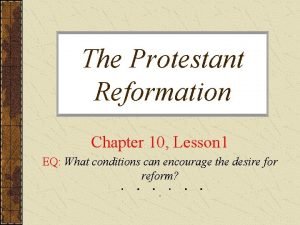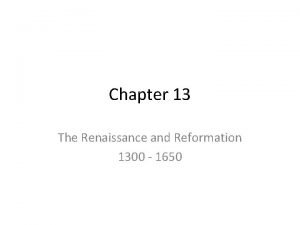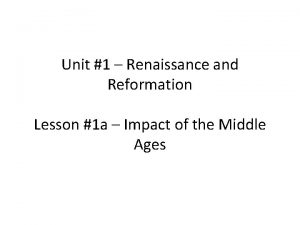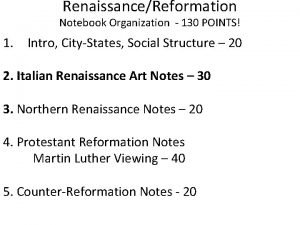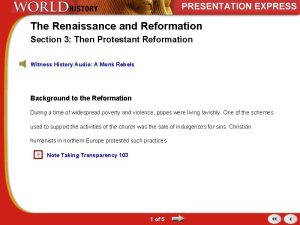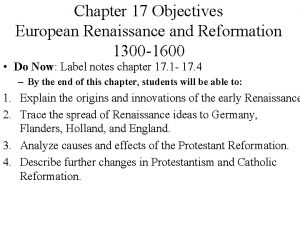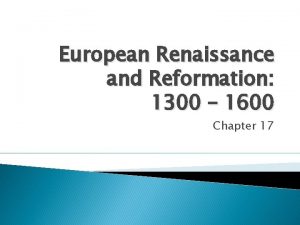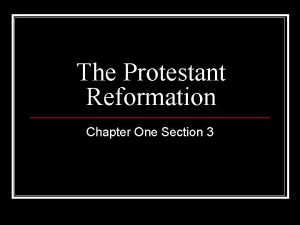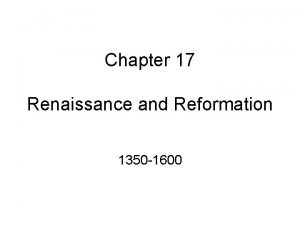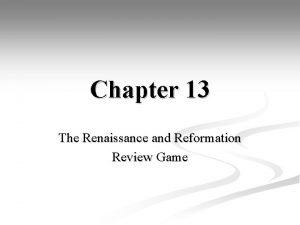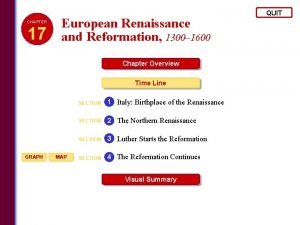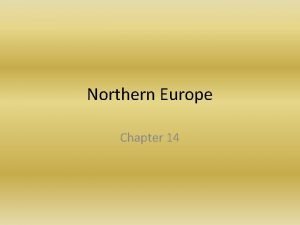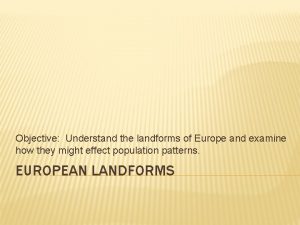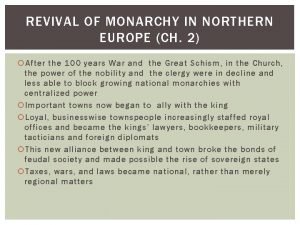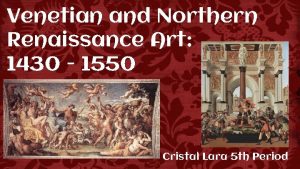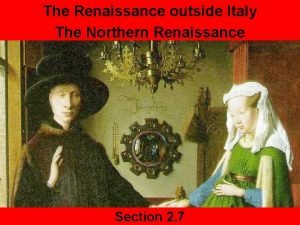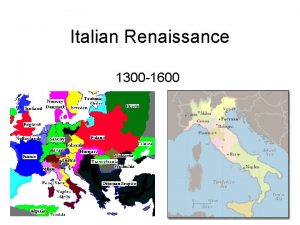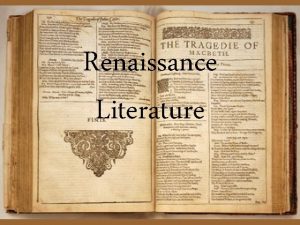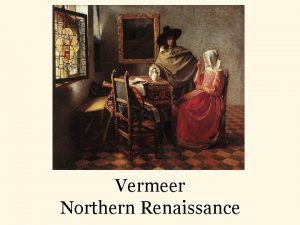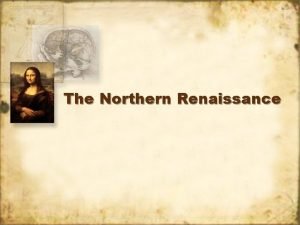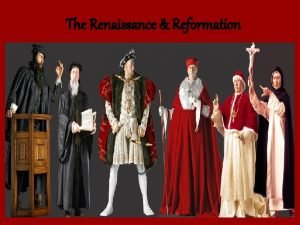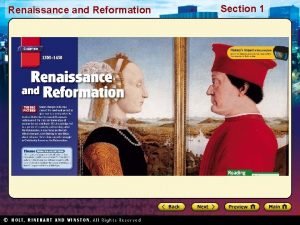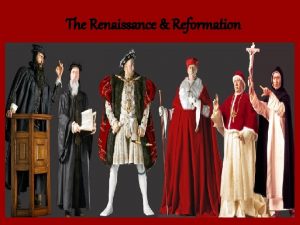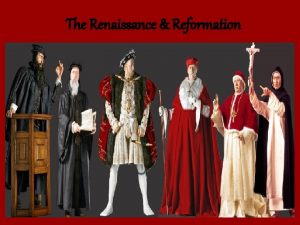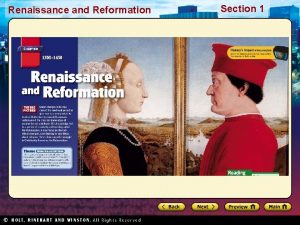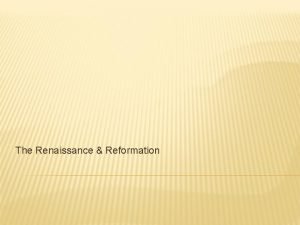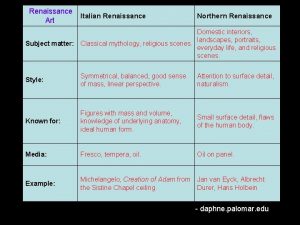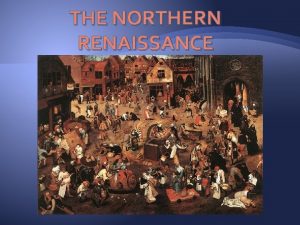The Northern Renaissance Reformation in Northern Europe Mix














































- Slides: 46

The Northern Renaissance Reformation in Northern Europe

Mix of civil and religious authority was rearranged Germany was split in its loyalty Switzerland pursued separation Italy remained true to the faith England didn’t reform, but switched head of the church Religion and Politics


JOHN CALVIN (1509 -64) • trained in humanism and law in addition to theology. • John Calvin of Geneva was a sophisticated Frenchman • succeeded in establishing a Swiss Protestant theocracy in the city-state of Geneva, • militant preaching inspired • Protestants all over Europe. • ultimate influence went beyond religion to economics.

His call for a capitalistic spirit based on unceasing labor in gainful pursuits for the glory of God may well have inspired the disciplined, rigorous drive that made Calvinist Huguenots and Puritans among the most successful businessmen in France and England, respectively. It has been suggested that Calvinism may have been an important cause in the growth of the capitalist system in the West.

ERASMUS (1469 -1536) born in Rotterdam, Germany • became the greatest scholar of the northern Renaissance. • important writer/analyst for Classical literature. • His written works gained him a reputation throughout Europe such as • Adages • In Praise of Folly. • wanted to see a massive program of education from which, he believed, would come a universal Christian church. • It was a gigantic task, but because the Church was rich, Erasmus believed it could be accomplished if the Church rethought its priorities and cut waste. • To this end, Erasmus appealed to the princes of Europe to take the lead in reforming the Church whenever the Church was unwilling to reform itself.

His best known work is the Praise of folly that he wrote on his way back from Italy. It is a pamphlet mainly directed against the behavior of leading classes and church dignitaries.

The entire world is my temple, and a very fine one too, if I'm not mistaken, and I'll never lack priests to serve it as long as there are men. In short, no association or alliance can be happy or stable without me. People can't long tolerate a ruler, nor can a master his servant, a maid her mistress, a teacher his pupil, a friend his friend nor a wife her husband, a landlord his tenant, a soldier his comrade nor a party-goer his companion, unless they sometimes have illusions about each other, make use of flattery, and have the sense to turn a blind eye and sweeten life for themselves with the honey of folly. Quotes from Praise of Folly

Man's mind is so formed that it is far more susceptible to falsehood than to truth. The nearer people approach old age the closer they return to a semblance of childhood, until the time comes for them to depart this life, again like children, neither tired of living nor aware of death.

Martin Luther was born in 1483 and died in 1546. He wrote that… faith is God's work in us, that changes us and gives new birth from God. (John 1: 13). It kills the Old Adam and makes us completely different people. It changes our hearts, our spirits, our thoughts and all our powers. It brings the Holy Spirit with it. Yes, it is a living, creative, active and powerful thing, this faith.

Faith cannot help doing good works constantly. It doesn't stop to ask if good works ought to be done, but before anyone asks, it already has done them and continues to do them without ceasing. Anyone who does not do good works in this manner is an unbeliever. He stumbles around and looks for faith and good works, even though he does not know what faith or good works are. Yet he gossips and chatters about faith and good works with many words. Faith is a living, bold trust in God's grace…. Here I stand…

HENRY VIII of ENGLAND (1509 - 1547 ) Henry VIII built upon the innovations instituted by his father. The break with Rome, coupled with an increase in governmental bureaucracy, led to the royal supremacy that would last until the execution of Charles I and the establishment of the Commonwealth one hundred years after Henry's death. Henry was beloved by his subjects, facing only one major insurrection, the Pilgrimage of Grace, enacted by the northernmost counties in retaliation to the break with Rome and the poor economic state of the region. History remembers Henry in much the same way as Piero Pasqualigo, a Venetian ambassador: ". . . he is in every respect a most accomplished prince. "


ALBRECHT DURER (1471 -1528) Durer, whom many regard as Germany's greatest artist, could be described as the Leonardo of the northern Renaissance. Went to Italy to discover early Renaissance painting techniques (i. e. the major breakthroughs) Both were transitional figures and, at the same time, innovators. Durer shared Leonardo's deep curiosity about the natural world, a curiosity that is expressed especially in his drawings, which explore the human figure and physiognomy, animals, plants, and landscape. Like Leonardo, Durer explored aesthetic theory and wrote a treatise on proportion. Also like Leonardo, Durer was gracious, handsome, courted throughout Europe, and respected by his fellow artists. Unlike Leonardo, however, Durer worked principally as an engraver and was tortured by religious problems.



JAN VAN EYCK (c. 1390 -1441) "The prince of painters of our age, “ was the way one of his contemporaries described Jan van Eyck, whose work advances the new naturalism of the age. Although little is known about his life, he seems to have been an active and highly placed functionary of the Duke of Burgundy. On one of his trips in the duke's service, van Eyck visited Italy, where he met Masaccio and other Florentine artists. Without doubt, van Eyck was one of the greatest artists of any age, and he brought a new "reality" to painting in such works as The Arnolfini Marriage.


Hands clasped Candle symbolizing the light of Christ. Shoes – barefeet on solid ground St. Catherine on the bedpost – patron saint of childbirth. Mirror reflecting artist. Marriage bed – fertility and children Dog symbolizing fidelity

The mirror is painted with almost miraculous skill. Its carved frame is inset with ten miniature medallions depicting scenes from the life of Christ. Yet more remarkable is the mirror's reflection, which includes van Eyck's own tiny self-portrait, accompanied by another man who may have been the official witness to the ceremony. Symbol of faithfulness Almost every detail can be interpreted as a symbol. The companion dog is seen as a symbol of faithfulness and love. The fruits on the window ledge probably stand for fertility and our fall from Paradise. Even the discarded shoes are not thought to be incidental, but to signify the sanctity of marriage.



The artist and the backs of the couple. All around the mirror are scenes from the life of Christ.

Symbolic candle The solitary flame burning in bright daylight can be interpreted as the bridall candle, or God's all-seeing eye, or simply as a devotional candle. Another symbol is St Margaret (the patron saint of women in childbirth), whose image is carved on the high chairback. An elaborate signature As today, marriages in 15 th-century Flanders could take place privately rather than in church. Van Eyck's Latin signature, in the Gothic calligraphy used for legal documents, reads: ``Jan van Eyck was present'', and has been interpreted by some as an indication that the artist himself served as a witness.

HEIRONYMUS BOSCH (c. 1450 - August 1516) Hieronymus, or Jerome Bosch, spent his entire artistic career in the small Dutch town of Hertogenbosch, from which he derived his name. At the time of his death, Bosch was internationally celebrated as an eccentric painter of religious visions who dealt in particular with the torments of hell.




PIETER BREUGEL (c. 1525 – 1569) Nicknamed ‘Peasant Bruegel’ was probably the most significant and exciting painter in the Northern Europe during the middle part of the sixteenth century. His nickname “Peasant Bruegel” indicates his favorite subjects: peasant life, proverbs and genre scenes. He also set New Testament topics among common folks of contemporary Flanders. “Although Bruegel was famous in his own lifetime, the archaic tone of much of his imagery and his refusal to adopt the idealized figure style evolved by Italian Renaissance artists had, in sophisticated circles, an adverse effect on his reputation both during his life and after his death” (Keith Roberts).


Pieter Breugel (1528 – 1569) The Triumph of Death

Flemish Proverbs (1559)

In this tour de force of 92 visualizations of local proverbs, Brueghel shows, midpicture, Aesop’s fox duly bibbed and frustrated, waiting for soup sustenance from his “friend” the crane, who is happily sipping from a narrow earthenware vase. In the right lower corner “he who spills gruel cannot get it all up, ” shows a hungry man with a big spoon trying to scoop up the spilt kettle of gruel from the ground back into the pot. Others included are: “He blocks up the well after the calf is drowned, ” “One shears the sheep, another the pig, ” “One holds the distaff, which the other spins, ” “The pig has been stuck though the belly”;

Upper left

Lower Left

Upper right

Lower right

Jan Brueghel the Elder (1568 -1625) Because of his fondness of certain subjects and glowing enamel paint, Jan, the second son of Pieter Breugel was given the nickname “Velvet” or “Flower” Brueghel. Jan Brueghel the Younger (1601 -1678) Pieter Brueghel the Younger (1564 -1638) called Hell Breugel for his facination with fires, goblins and the like. The Breugel Family

Jan Breughel the Elder Adam and Eve in the Garden of Eden. 1615

Jan Brueghel the Elder. Bouquet in a Clay Vase. c. 15991607

Jan Brueghel the Younger. Paradise. c. 1620

Pieter Breughel the Younger The Peasant Wedding. 1620.

The Dutch Renaissance excelled in portraying comfortable interior scenes that are composed with mathematical clarity and suffused with cool, silvery light Vermeer was a master of composition and in the representation of space. He arranged tonal values and perspective over the foreground, into the middleground, and farther into the distance 35 of Vermeer's canvases have survived, and none appears to have been sold ◦ Their small number is the result of Vermeer's deliberate, methodical work habits, comparatively short life, and the disappearance of many of his paintings during the period of obscurity following his death in Delft on Dec. 15, 1675 Jan Vermeer

Girl Asleep At a Table

Girl with a Pearl Earring

https: //play. kahoot. it/#/? quiz. Id=e 15 abd a 1 -30 a 2 -437 c-b 86189 d 3745978 b 9&game. Mode=ghost&start. Ti me=1457705744822 - Kahoot game! STUDY!!!
 How did the renaissance develop in northern europe?
How did the renaissance develop in northern europe? Unit 12 lesson 2 the renaissance in northern europe
Unit 12 lesson 2 the renaissance in northern europe Italian renaissance vs northern renaissance venn diagram
Italian renaissance vs northern renaissance venn diagram Flemish renaissance art characteristics
Flemish renaissance art characteristics The reformation outcome martin luther and the reformation
The reformation outcome martin luther and the reformation The reformation outcome: martin luther and the reformation
The reformation outcome: martin luther and the reformation Protestants vs catholics
Protestants vs catholics The reformation in europe lesson 1
The reformation in europe lesson 1 Chapter 13 the renaissance and reformation
Chapter 13 the renaissance and reformation Lutheranism and calvinism
Lutheranism and calvinism Chapter 12 renaissance and reformation worksheet answer key
Chapter 12 renaissance and reformation worksheet answer key European renaissance and reformation answer key
European renaissance and reformation answer key Unit 4 lesson 1 the renaissance
Unit 4 lesson 1 the renaissance Renaissance and reformation interactive notebook
Renaissance and reformation interactive notebook The renaissance and reformation section 3 quiz
The renaissance and reformation section 3 quiz European renaissance and reformation chapter 17
European renaissance and reformation chapter 17 Chapter 17 european renaissance and reformation
Chapter 17 european renaissance and reformation Why did the sale of indulgences become a critical issue
Why did the sale of indulgences become a critical issue Renaissance and reformation vocabulary
Renaissance and reformation vocabulary Chapter 17 renaissance and reformation
Chapter 17 renaissance and reformation Chapter 13 the renaissance and reformation
Chapter 13 the renaissance and reformation European renaissance and reformation
European renaissance and reformation European renaissance and reformation chapter 17
European renaissance and reformation chapter 17 One way that renaissance artists reflect
One way that renaissance artists reflect Product mix vs marketing mix
Product mix vs marketing mix Why did missionaries travel to northern europe
Why did missionaries travel to northern europe What is northern europe called?
What is northern europe called? The physical geography of northern europe
The physical geography of northern europe Natural resources of northern europe
Natural resources of northern europe Landforms of europe
Landforms of europe Monarchy in northern europe
Monarchy in northern europe Physical geography of northern europe
Physical geography of northern europe Northern renaissance art characteristics
Northern renaissance art characteristics Venetian and northern renaissance (1430–1550)
Venetian and northern renaissance (1430–1550) Italian city states of the renaissance
Italian city states of the renaissance The northern renaissance began in the cities of
The northern renaissance began in the cities of Northern renaissance literature
Northern renaissance literature The renaissance writers
The renaissance writers Lesson 1 the renaissance 1485
Lesson 1 the renaissance 1485 Northern renaissance characteristics
Northern renaissance characteristics Which movement
Which movement Northern renaissance portraits
Northern renaissance portraits Northern renaissance art characteristics
Northern renaissance art characteristics Vernacular
Vernacular Northern renaissance portraits
Northern renaissance portraits Italian and northern renaissance similarities
Italian and northern renaissance similarities Giovanni de medici
Giovanni de medici
